Did Kitchener’s decision to raise his ‘New Armies’ carelessly wreck the pre-war plans to achieve smooth and effective British military expansion?
- Home
- World War I Articles
- Did Kitchener’s decision to raise his ‘New Armies’ carelessly wreck the pre-war plans to achieve smooth and effective British military expansion?
The Liberal Party, which had been in power since the General Election of 1906, was nervous of German expansionism and had, by 1914, edged Britain into a much closer relationship with Russia and France than had previously been the case. Brigadier-General Henry Wilson, who was appointed Director of Military Operations in 1910, has traditionally been seen as a major reason for the British being committed to a mass army operating on the continent.
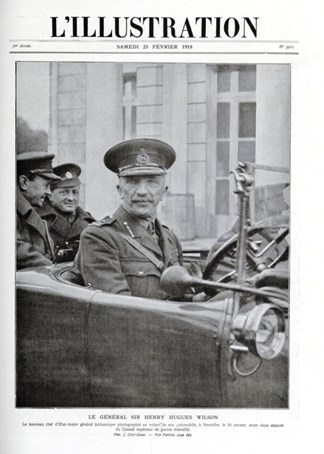
Whether Wilson was or was not the driving force behind Britain's perceived commitment to send an expeditionary force to France, the fact remains that conversations took place between the French and British military. These conversations resulted in plans being put in place for an expeditionary force of six infantry divisions and one cavalry division to be sent to France in the event of a war. The decision to send this "contemptible little army", although comprising a very large proportion of the pre-war British Army, raised no requirement to provide a mass army on the continental scale. The subsequent change in scale of the commitment in August 1914 is directly attributable to Kitchener being appointed Secretary of State for War within hours of the declaration of war.
In the 30 to 40 years before the outbreak of the Great War, there had been two major reforms of the army, these being the Cardwell reforms of the 1880s, and the Haldane reforms of 1905-1912. Although the Cardwell reforms were much more fundamental to the structure of the regular army, the Haldane reforms directly affected the size and type of BEF that Britain was eventually to send to France. Haldane, who was Secretary of State for War until 1912, was not hoping to create - or even prepare for - an army on the continental scale, but he is quoted as saying Britain 'needed a highly-organised and well equipped striking force'.
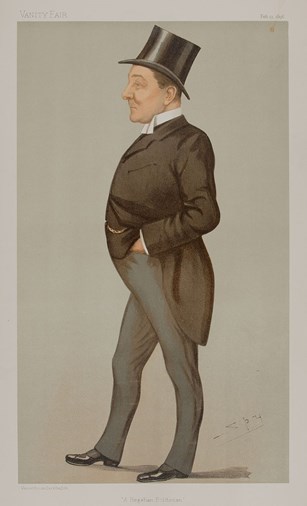
Above: Haldane caricatured by 'Spy' in Vanity Fair, 1896
At the time he started these reforms it was far from clear where this striking force would operate; since it was not obviously going to operate in Europe, he could hardly have started preparing for a European-sized army. As part of the reforms, Haldane set about increasing the reserve forces by creating the Territorial Force. Major-General Douglas Haig, who as Director of Military Training was assisting Haldane with the creation of the new Territorial Force, had advocated its size should be of the order of 900,000 [2].
Due to perceived difficulties in achieving Haig's 900,000 target, Haldane cut the size of the projected Territorial Force to 300,000. Whilst this may have been a more realistic figure, it can be seen in retrospect as the first step towards the creation of the mass citizen armies of 1914. Of equal relevance is Haldane's observation that the Regular Army must be professional and should not be raised by conscription [3].
Haldane's plans did however give some thought to expansion. Simkins quotes [4] Haldane referring to the increase in size of the striking force being made through the Territorials:
It might be possible.....[to finance the expansion] if that skeleton of expansion of which I have spoken is lying behind, which will become a very real expansion in time of national emergency...
As suggested by the above quotation, Haldane was operating in a government that gave money grudgingly to the armed forces; the Liberals had social plans that ensured that military expenditure was constrained. Despite - or possibly because of - this constraint, Haldane planned to use the Territorial Force as the method of expansion.
Without the certainty of a European war, Haldane had to plan for any number of possible scenarios; this limited his ability to make plans for the future role of the army on the continent and plan for its reinforcement. Having accepted a continental commitment, albeit on a small scale, Haldane, like the majority of his contemporaries, envisaged a short war. Such a short war would avoid the need for any major expansion of the army; in this scenario, the BEF would simply require replacement of casualties, which could be achieved through the usual recruitment channels. Units of the Territorial Force that had volunteered for imperial service could also be used for additional reinforcement of the BEF [5].
To take this discussion further, it is necessary to analyse the ability of the Territorial Force to carry out its role as the preferred method of the planned modest expansion.
The Territorial Force came into existence on 1 April 1908. It reached its peak, pre-war size in 1909, with 270,041 men having joined the force, this being 89% of its establishment. By September 1913, however, its strength had fallen to around 80% of establishment, with wastage running at nearly double that of the Regular Army [6]. Not only did the Territorial Force fail to recruit up to the revised 300,000 establishment and men who completed their time with the force were not replaced in sufficient numbers, but there also seems to have been problems with morale [7].
As the Territorials were intended for Home Defence only, and prior to the war only a disappointing 20,000 (or 7%) had accepted the liability of overseas service [8], there was a great deal of doubt if this force would be willing to serve overseas. The Regulars seem to have had little confidence in the Territorials and - significantly - the Territorials had few friends in the military establishment. In addition, Territorial Force artillery proficiency proved controversial in 1908 and, as late as 1912, no mobilisation scheme was in existence for the force [9]. Under these circumstances there can be little surprise that Kitchener was said to be wary of using the Territorial Force.
J E B Seely replaced Haldane as Secretary of State for War in 1912, but Seely was forced to resign over the Curragh incident in 1914, with the Prime Minister, Herbert Asquith, acting as Secretary of State for War in the period March to August 1914.
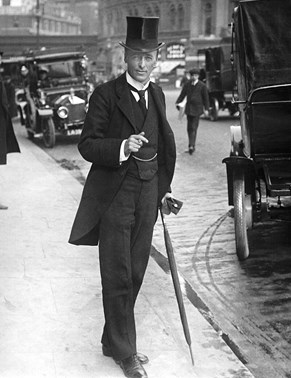
Above: JEB Seely in 1912
It is difficult to assess how this development affected the mobilisation of the army. Asquith could not (and did not) retain both roles and it is interesting to speculate if his temporary dual role led him to not question the 'short war' theory. Had Seely or another politician other than Asquith been holding the position of Secretary of State for War, the realisation that a major continental war was inevitable and that it may not be a short war may have become apparent. Such an early realisation might have allowed plans to be advanced for an expansion of the army through Haldane's Territorial Force.
Upon the outbreak of war, Asquith realised he could not continue to combine the role of Prime Minister and Secretary of State for War and, under pressure from the popular press, appointed Kitchener as Secretary of State for War.
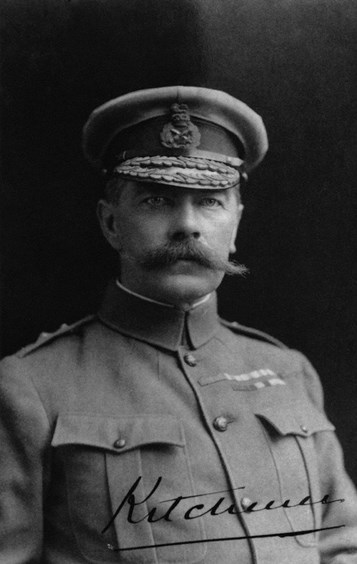
Above: Horatio Herbert Kitchener, 1st Earl Kitchener of Khartoum, 1901 (Duffus Bros, platinum print/NPG P403)
Haldane was an alternative, but he was perceived in the press as having pro-German sympathies. Had Asquith disregarded popular sentiment and appointed Haldane, it seems more than likely that Haldane would have turned to 'his' Territorial Force as the method of expanding the Army. Nevertheless, Kitchener was appointed and he perceived what virtually everyone else failed to see: that the war would not be short and, if Britain was to have a voice at the post-war settlement, she would need to have an army fighting alongside the French of at least a comparable size. It would seem that Kitchener's idea of the size of the army changed at regular intervals during the war: from thirty divisions in August 1914, to fifty divisions in mid-September and eventually to seventy by July 1915.
Although the ever-increasing size of the army was possibly a manifestation of Kitchener's indecision, he certainly shook his new cabinet colleagues by announcing, at his first Cabinet meeting on 7 August: 'We must be prepared to put armies of millions in the field, and to maintain them for several years' [10]. By the time of this meeting, the first of Kitchener's appeals had already appeared in the press, but the issue now was, how exactly did Kitchener plan to expand the army?
One way to go about this was via the expansion of the Territorial Force which Haldane had previously suggested as the method of reinforcing the "striking force" but, as is well known, Kitchener did not use this option. Magnus states [11] that Kitchener despised the Territorial Force 'on account of its amateur spirit which he regarded as incurable....they were [a] characteristically untrained and unprofessional product of... the mind of Haldane'. Simkins [12], however suggests that Kitchener's attitude to the Territorials was not quite so black and white as popularly believed.
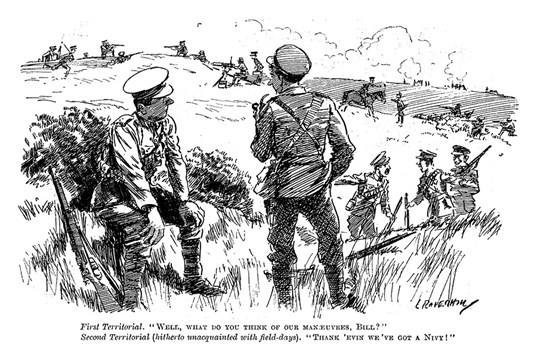
Above: "Thank heavens we've got a navy". Contemporary perception of the Territorial Force's ability to defend the nation against invasion, published in Punch less than three months before the start of the First World War.
There is evidence that Kitchener was prejudiced against the Territorials due to his coming into contact with the French equivalent in the Franco-Prussian war, and his mistrust was also based on the fact that they were not wholly under War Office control (they were largely administered by local associations). However, as Simkins points out, it was entirely reasonable to avoid swamping the Territorial units with a flood of new recruits when their role by 1914 had come to be regarded as home defence. This home defence role, which they would undertake simultaneously with a process of recruitment to bring the units up to establishment, Simkins suggests, was a sensible and rational plan; besides, Kitchener could not anticipate if these units would commit themselves to overseas service.
Beckett contends [13] (seemingly in support of the theory that the Territorial Force should have been used as a method of expansion) that the New Armies, like the Territorial Force, could not be expected to expand and train equally successfully. (By implication it was possible to expand or train, but not both.) Beckett, however, avoids the point that whilst expansion and training were hurdles for both the Territorials and New Armies, the additional hurdle of carrying out its Home Defence role was a major reason for keeping the Territorial Force to a manageable size. If the Territorials had been swamped as the New Armies were to be, there is little doubt that the role of Home Defence would have had to have been carried out by regular forces, at the expense of reinforcing the badly stretched BEF.
It is, with hindsight, easy for us now to underestimate the importance of the role of Home Defence, knowing that a German invasion was never going to take place, but that was not the case in 1914. The threat of a German invasion was real, and the undertrained and understrength units of the Territorial Force had an important role to fulfil in protecting the country's coast from the Germans. It would probably have been incapable of fending off an invasion if it was in the process of a major expansion and training programme.
Under these circumstances, it is somewhat surprising that Kitchener allowed the Territorials to recruit at all, but he did; orders being issued that County Associations were allowed to raise second line battalions to replace those units that had volunteered to serve abroad. By late August, over seventy territorial battalions had volunteered. This shows that his initial fears of the Territorials not volunteering, or worse, absorbing recruits who would use this method as a way of avoiding front line service, were unfounded.
As is well recorded, Kitchener chose to expand the army by creating 'New Armies'. Kitchener's choice of using the Scottish, Irish, Northern, Eastern and Western commands (plus the raising of Light Divisions) may have worked for a time but the system had to be amended after the first two New Armies were formed due to the regional disparity of available recruits [14]. If a regular and orderly expansion of the Army was desired, clearly Kitchener's appeals for several blocks of 100,000 volunteers within the first few weeks of the war was going to adversely affect this measured expansion. However, Kitchener's motives for a massive early expansion were probably due as much to the politics of the Liberal Government as to Kitchener's own autocratic methods. Following Asquith appointing the Conservative [15] Kitchener as Secretary of State, Asquith relied on Kitchener's prestige to help him retain the confidence of the country. Although there were exceptions, the Liberal party was against conscription and Asquith needed to avoid any inter-party conflict on this subject. As much, therefore, as Kitchener relied on Asquith for his position, Asquith relied on Kitchener keeping in step on the subject of 'no conscription' to keep control of the Liberal party.
It was, of course, possible that there would have been a recruiting surge of an equally phenomenal size even without Kitchener's backing but, whilst ever Kitchener appeared to be the magnet drawing in the recruits, there was, in the early weeks of the war, no danger of conscription being needed. Kitchener and Asquith may have realised that the wave of patriotism could not be sustained indefinitely. If conscription was to be avoided, or put off for as long as possible, it would be necessary to recruit as many men as possible into the army whilst they were willing to volunteer. It is possibly for this reason, more than any other, that the uncontrolled expansion of the army was allowed to take place during September 1914.
Three of the most difficult issues the army had to deal with during the autumn and winter of 1914 were accommodation problems [16], lack of equipment and clothing for the recruits and, linked to both of these factors, the difficulty of undertaking training exacerbated by the lack of officers and trained instructors.
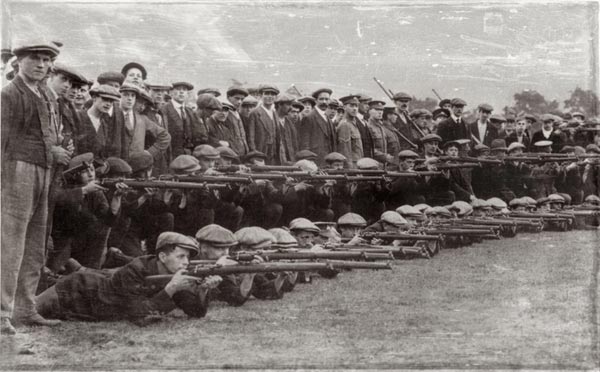
Above: Grimsby Chums, in training
These and other factors, such as the breakdown in the system of paying separation allowances, would undoubtedly have depressed the rate of recruiting. Whilst this may have had a negligible effect overall due to the overwhelming nature of the rush to the colours, it would have been at odds with Kitchener's likely aim of getting as many men by voluntary means as possible before the surge of enthusiasm waned. The obvious strains in the system led to an attempt, during September, to reduce the flow of recruits by the means of increasing the minimum height requirement. Not only did the attempt to limit the flow of recruits slow the rate of recruitment, it also had another, possibly unforeseen, consequence: it sent a signal that the army was not necessarily as keen as before to recruit. As a result, it was likely that many potential recruits decided not to enlist, and they were lost to the volunteer army.
Many of the problems faced by the army in this period have been laid at Kitchener's door due to his unwillingness to use existing procedures [17]. It is clear, however, that the use of the existing recruiting channels would have been entirely inappropriate. Simkins gives numerous examples of the inability of the recruiting officers and doctors to deal with the flood of recruits literally banging on the doors. Many recruits seem to have been given cursory medical examinations and were passed as fit when they were not up to standard, and the depots soon became full to overflowing with recruits.
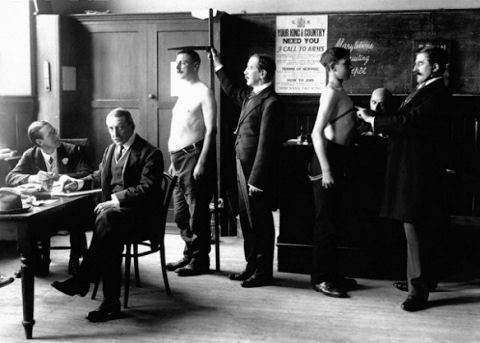
Above: Medical examination of recruits, c. 1914
The percentage of men who were recruited despite being medically unfit will have varied at different times during the war; as the bottom of the barrel was being reached, and ever more marginal cases would have been tolerated. The fact that many were incorrectly passed as fit for service in the early weeks is attributable to the lack of pre-war planning for the expansion of the army. Doctors were under pressure to examine recruits very quickly, and were paid per recruit rather than per hour [18]. This, together with the recruiting sergeants being paid a bounty per man enlisted, would have ensured many men enlisting into the army who should not have been able to do so. Both of these are examples of issues that could have been corrected before they occurred had there been a suitable plan in place.
It is well recorded how the depots quickly filled with recruits, with men sleeping in overcrowded and often insanitary conditions. The problem was addressed by ordering the recruits to be passed into training camps as quickly as possible, but this only repeated the problems further down the system with incomplete, and frequently muddy, camps holding recruits who sometimes did not even have basic eating utensils [19].
Kitchener, as ever, used expedients to overcome the problem of the lack of officers in the New Armies. Officers at home on leave from the Indian Army found themselves in command of battalions of New Army recruits; similarly Territorial battalions suddenly lost their regular officers and NCOs to New Army battalions [20]. It should be noted, however that this was not a universal occurrence [21]. Whilst undoubtedly there was a chronic lack of officers, particularly in the Second and subsequent New Armies, and Kitchener's methods did help the problem, there were to be knock-on effects which were either not foreseen or were brushed aside. For instance the Indian Corps was much more reliant on its officers, and the difficulties of replacing those officers who could communicate to the 'native' troops in their own language was not easily overcome.
Kitchener recognised there were bottlenecks in the system so, overcoming his reluctance to use the Territorial infrastructure, in early September 1914 he agreed that the Territorial Force County Associations might be allowed to take a part in the housing, clothing and training of the New Army recruits [22]. For various reasons, this assistance only lasted a week, but was called on again in December. Perhaps the most surprising aspect of the use of the Territorial Force Associations was the request made for these associations to form New Army units and, even more surprisingly, the fact that five Territorial Force Associations raised seven New Army infantry battalions [23].
It is possibly the fate of the recruits in the depots and the camps that led Kitchener to bypass his own system in allowing locally raised battalions to be recruited and administered until such time as the War Office was in a position to take them over. These locally raised units, more commonly known as Pals Battalions, are popularly regarded as the supreme example of the wave of patriotic recruitment that took place in 1914.
Whilst this is true, they also show Kitchener's pragmatic outlook in allowing non-government organisations to raise what were, in effect, private armies. This process certainly eased the pressure on the system but, with the benefit of hindsight, this caused its own set of problems in the aftermath of 1 July 1916.
An attempt to bring order to the chaos was made by The Parliamentary Recruiting Committee (constituted on 31 August 1914) which, according to Simkins [24], was intended by the government "to pull diverse strands of recruiting together". Thornton suggests that despite this attempt at co-ordination, the 'rival' organisations of the New Armies and Territorials carried on competing for an ever-reducing number of volunteers [25].
It is possible to argue that Kitchener's contribution to recruiting has been overstated; after all, queues formed at recruiting offices before his appeal was published, and there was no immediate reaction to his appeal [26].
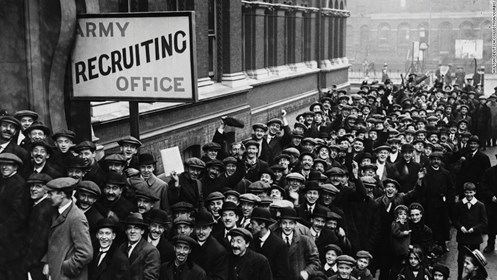
Above: Recruits at Walworth town hall in London
Furthermore, Simkins states that the increase in recruiting was due to civilian efforts and the boom of September was soon over [27]. Certainly there are examples of spontaneous actions (such as the emergency meeting of the Staffordshire Territorial Force Association) being undertaken without Kitchener having uttered a word [28]. However, as mentioned earlier, Kitchener did without doubt attract volunteers into the army and it is unlikely any other personality would have had the same effect.
It is entirely feasible that Asquith could have appointed someone other than Kitchener as Secretary of State for War. Whomever he had appointed would have faced some of the same problems, but some - of Kitchener's own making - would have been avoided. Haldane - although unacceptable to the press - would surely have used the Territorial Force as the method of expansion. Lord Derby, had he been appointed, could well have expanded the locally raised element.
Both would have faced difficulties of a rapidly expanding and untrained mass of recruits. The use of the Territorial Force would have dislocated this force and have necessitated regulars not going overseas, in order to sustain a home defence element. On the other hand, an entirely locally raised new army would still have been no quicker in reinforcing the BEF than Kitchener's method.
Greater emphasis on locally raised units would possibly have meant less hardship for recruits as the local organisations would have taken charge of billeting and provisions, but the problems due to the lack of instructors could not have been overcome [29]. Locally raised units may have resulted in these battalions having more sense of independence, and therefore they may have been less easy to integrate into the army structure.
Simkins does identify a middle that was tried in Birmingham, in which locally raised units recruited at a steady and measured pace [30]. This seems to have not been totally successful as recruits became impatient, and joined other units that were more ready to accept them immediately.
The sudden and uncontrolled expansion did have effects elsewhere. Had the war been, as was suggested prior to 1914, a short war, there would have been little dislocation to Britain's industries; there would have been no need for expansion of munitions industries other than possibly a short-term increase in output of the existing capacity. Shipbuilding would not have been affected, and many other ancillary industries, such as textiles for the clothing of the army, would have needed no government pre-planning.
The recruiting surge should have brought about a change in the 'light touch' strategy of government on industry, as the war and the recruitment drive seriously affected many industries. Simkins gives figures [31] of over 20% of male employees having enlisted in the army from the chemical and explosives industries, from electrical engineering, and from the mines; even more worrying was the figure of 16.8% from small arms manufacturing. To allow uncontrolled enlistment from these industries does show a lack of planning and foresight to the whole issue of recruitment which, even acknowledging the benefit of hindsight, did leave the Government in general, and Kitchener in particular, open to criticism.
In deciding to go for a major early expansion of the army, and avoiding using the Territorial Force as the method of achieving this expansion, Simkins suggests that Kitchener made the correct decision. Beckett seemingly agrees although he implies more use should have been made of the Territorial Force, suggesting that the Territorial Force was not so much as 20% under-strength as 80% full and, in any case, soon filled to its establishment. Beckett also asserts that whilst the New Armies did recruit faster than the Territorial Force, this was because restrictions were placed on the Territorial Force's ability to recruit [32]. A result of this was the Territorials sought out men with previous military experience [33].
With such internal competition for recruits, volunteers were likely to enlist in the unit that they believed would get them to France the quickest. Whilst it may have been perceived that the New Armies would get to France sooner, it was the first line Territorial Force divisions which arrived in France marginally earlier. This would not have been the case had the Territorial Force also recruited at a rate similar to the New Armies.
Beckett repeats Kitchener's statement that he wanted men who knew nothing rather than a smattering of the wrong thing, and his avoidance of the Territorial Force was instinctive rather than rational. Whether Kitchener's thought process was rational, as Simkins suggests, or instinctive, as Beckett does, hiss avoidance of the Territorial Force was, on balance, probably correct in the absence of any other plans for a large-scale expansion. Without a doubt it was vital to retain some element of Home Defence, and the Territorial Force was the only way of achieving this other than retaining regular forces at home.
Kitchener's call for men to join his 'New Armies' certainly bypassed the existing and inadequate pre-war recruiting channels of the Regular Army and Territorial Force, but his unwillingness to concentrate on one route led to a large scale duplication of effort. Additionally, his unwillingness to control the flow of recruits (apart from the one occasion when the minimum height requirement was increased) led to the entire system becoming clogged. Whilst the problems were somewhat alleviated by the use of local organisations, this by-passed his own system and in some respects simply created a three-way duplication of effort.
Despite the possible arguments to the contrary, Kitchener was certainly 'a good recruiting poster' and, whilst his methods may have led to problems, any alternative may have led to delays in the Territorial Force going overseas and could have led to a change in the outcome of the First Battle of Ypres.
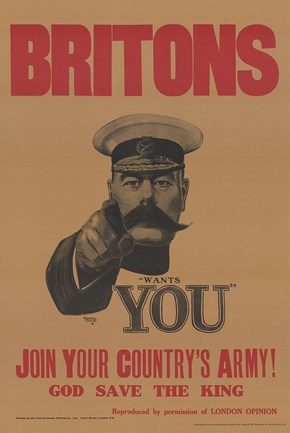
Any pre-war plan that existed was for a small expansion. As soon as the full commitment was made to send mass armies to France, a huge increase in the army became necessary. This expansion could have been achieved by conscription and this would have been more orderly in terms of billeting, equipping and training. It would also have ensured a totally different ethos for the 'cheerful mass citizen armies' that went to France. However, conscription was politically impossible for Asquith, and Kitchener was bound to support Asquith. Controlled volunteering could have been used but realising that this would soon dry up left the government and Kitchener no choice but to ride the wave of volunteering. By his actions in the massive and rapid expansion of the army, Kitchener supported the government in avoiding conscription. It is therefore somewhat ironic that he died just as conscription started and just before his New Armies went into action on 1 July 1916.
Article by David Tattersfield
Further Reading
‘Kitchener of Khartoum’ and HMS Hampshire
References:
1 Peter Simkins, Kitchener's Army - The Raising of the New Armies, 1914-1916 (Manchester University Press 1988) p.6.
2 Simkins, Kitchener's Army p.11. It is of note that this figure, and the fact that this army should be able to be maintained in the field for five years, is remarkably close to - and predates - Kitchener's appeal for one million men, and his prediction of a long war.
3 Simkins, Kitchener's Army p. 6.
4 Simkins, Kitchener's Army p.7.
5 Edward Spiers, The Late Victorian Army 1868-1914, in David Chandler and Ian Beckett, (eds.) The Oxford Illustrated History of the British Army (Oxford University Press 1994) p. 206.
6 Ian Beckett, The Territorial Force in Ian Beckett and Keith Simpson (eds.) A Nation in Arms : The British Army in the First World War. (Manchester University Press 1985) p.128.
7 Beckett, A Nation in Arms p.129.
8 Peter Simkins, The Four Armies 1914-1918, in David Chandler and Ian Beckett, editors The Oxford Illustrated History of the British Army (Oxford University Press 1994).
9 Beckett, A Nation in Arms p. 129.
10 Philip Magnus, Kitchener - Portrait of an Imperialist (John Murray, 1958) (paperback edition Grey Arrow 1961 p.273).
11 Magnus, Kitchener p.269.
12 Simkins, Kitchener's Army p.41.
13 Beckett, A Nation in Arms p.130.
14 It has been suggested that the decision not to use Southern Command was due to the dispatching of two Wessex and the Home Counties Territorial Divisions to India. However it is noteworthy that the pre-war commander of Southern Command was Horace Smith-Dorrien. Smith-Dorrien was no doubt earmarked at an early stage as the next senior general who would go overseas with the expanding BEF. Smith-Dorrien's likely early move to France may well have been a contributory factor behind not using Southern Command to raise New Army divisions.
15 Kitchener's sympathies were 'strongly Conservative': Magnus, Kitchener p.335.
16 Clive Hughes, The New Armies in Ian Beckett and Keith Simpson, (eds) A Nation in Arms (Manchester University Press 1985) p. 100, talks of ‘squalid conditions’ in makeshift camps. Also (p.109) he implies recruits would have been put off joining by the lack of uniforms.
17 Although in fairness to Kitchener the Territorials also had accommodation problems which cannot reasonably be blamed directly on Kitchener. See Andrew Thornton, 'Recruiting for the Territorial Force in Staffordshire, August 1914 - December 1915', Journal of the Centre for First World War Studies, Volume 1, No 2 (Nov 2004).
18 Hughes, New Armies, p.102.
19 The problem of accommodation was only overcome by the billeting of recruits on the civilian population. See Peter Simkins 'Soldiers and civilians: billeting in Britain and France' in Ian Beckett and Keith Simpson, editors, A Nation in Arms (Manchester University Press 1985) pp.166-178.
20 Beckett, A Nation in Arms p.131.
21 Some regular NCOs were kept back to train both the First and Second Line Territorials. David Tattersfield, 'A Village Goes to War', (2000). pp.171-172.
22 Simkins, Kitchener's Army, p.73.
23 Brigadier EA James. British Regiments 1914-1918. Naval and Military Press 1998.
- The 16th Battalion Notts & Derby Regiment (Chatsworth Rifles) was raised by the Duke of Devonshire and the Derbyshire TFA;
- The 11th Battalion Suffolk Regiment (Cambridgeshire) was raised by the Cambridge and Isle of Ely TFA;
- The 13th Battalion, Royal Welsh Fusiliers (1st North Wales) although passed to the WNEC was raised by the Denbigh and Flint TFA;
- Lord Nunburnholme and the East Riding TFA raised the 10th, 11th, 12th, and 13th Battalions of the East Yorkshire Regiments (1st to 4th Hull).
24 Simkins, Kitchener's Army, p.61.
25 Thornton, Recruiting in Staffordshire p.9.
26 Simkins, Kitchener's Army p.54.
27 Simkins, Kitchener's Army p.55.
28 Thornton, Recruiting in Staffordshire p.2..
29 It is difficult to assess if training was a problem for the Fourth and Fifth New Armies. On 1 July 1916 - the first time these units went into serious action - the 30th, 31st, 32nd and 34th divisions all took part. (In addition was the 36th which, whilst technically Fourth New Army, was different to the others in that it was raised from the pre-war UVF). These divisions had mixed fortunes, from the 30th Division being successful, to the disaster of the 31st Division at Serre.
30 Simkins, Kitchener's Army p.86.
31 Simkins, Kitchener's Army, p.111.
32 The Territorial Force was initially only allowed to recruit up to peacetime establishment. (Thornton, Recruiting in Staffordshire p.4).
33 Thornton, Recruiting in Staffordshire p.5.





